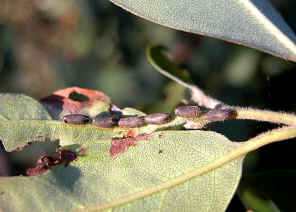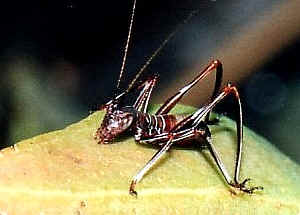Katydids - Family TETTIGONIIDAE
This page contains pictures and information about katydids that we found in the Brisbane area, Queensland, Australia.

Members in this family include Katydids, Long-horned Grasshoppers and Bush Crickets. Most of them are green in colour with leaf shaped wings that are held roof-like over the body. They have very long antenna, usually longer than their body length. Katydids have large hind legs for jumping.
Many katydids are nocturnal and rest during the day, well camouflaged on vegetation. Most of them are tree foliage feeders, they feed on leaves, flowers or seeds. A few of them are predaceous species, some are omnivorous or scavengers. Most of the katydids are resemble plants, such as leave, twigs, lichens or flowers. Nymphs are usually resemble ants, spiders or young bugs.
The common name "Katydid" is after a species whose song sounds like "Katy-did". They produce the sound by file on left wing and scraper on right. Female of some species will answer the males by different stridulation mechanisms. Some species sing in the frequency that too high for human to hear.
Females have sword-like ovipositor and lay eggs by inserted into leaf. Many species that males produce large spermathecae when courtshipping which females eat.
Most katydid species are herbivores feeding on variety of plants. Some feed only on leaves, others on flowers or fruits. A few species are predators. Many of them are active at night although some are active during the day.
Nymphs are usually very different from the adults. This allow them to live in different habitats and conditions. Some species the nymph resemble ants to avoid being eaten. Most adults camouflage as leaves.
We found quite a number of different Katydid species in Brisbane.
Subfamily Conocephalinae - Meadow Katydids
- Blackish Meadow Katydid

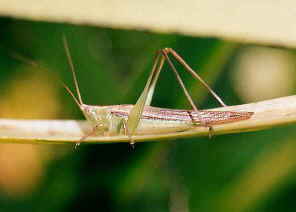
- Conocephalus semivittatus, nymph, adult, body length 15mm-20mm
- Blackish Meadow Katydids live on grasses and have very long antennae. Their body is pale green in colour with dark brown on the back. Adults may have fully developed wings in dark brown colour, or un-developed wings. There are more pictures and information in this page.
- Red Meadow Katydid
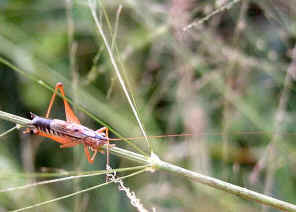
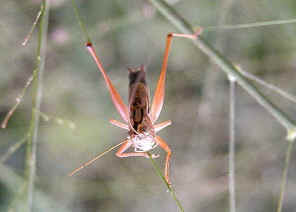
- ? Coptaspis sp., subfamily Conocephalinae, body length 20mm
- This katydid is orange-red in colour. Its wings covered half of its abdomen. It was found in Wishart bushland in a early winter evening. It looks like a Meadow Katydid but we not quite sure. Please advise if you know its identity.
- Spine-headed Katydid


- Nicsara sp. nymph and adult, body length 40mm
- We carefully opened a bundle of leaves it and found the Spine-headed Katydid nymph hiding inside. We took the nymph home, fed it with fresh gum leaves. Few days later, it did the final moulting and became an adult. For more pictures and information please visit this page.
Subfamily Meconematine
- Diurnal Predatory Katydid, Swayer

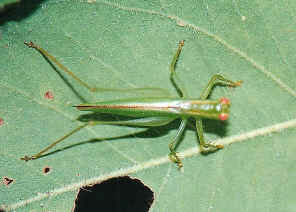
- Austrophlugis sp, body length 25mm
- We sometimes see this Diurnal Predatory Katydids in Yugarapul Park in Brisbane during mid summer. This katydids are green in colour with spiny legs. They have a pair of large eyes on their head. They are fast moving wandering on plants. More pictures and information please click here.
- False Leaf Katydid
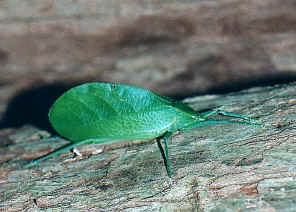
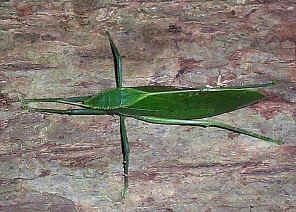
- Mastigaphoides sp., body length 60mm
- This katydid looks exactly like a leaf. We found this in Lamington National Park at night in late summer. It was resting on a tree trunk. It should be on the tree top. Also notice that both its long antennae were broken. Something must had happened to it.
Subfamily Pseudophyllinae
Subfamily Phaneropterinae - Bush Katydids
- Gum Leaf Katydid
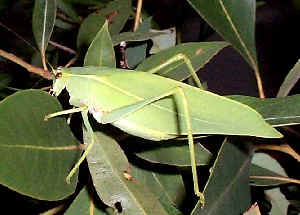
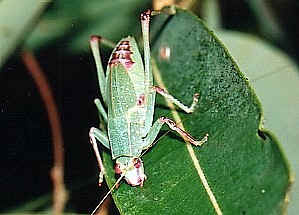
- Caedicia sp., female length 60mm, nymph length 30mm.
- This katydid resembles a gum tree leaf. We found it feeding on a gum tree at night in Wishart in late summer. Notice the openings on its front legs. They are the organs function like our ears, are to hear. The female katydid uses them to locate the males by their love songs. We have more information about them on the Gum Leaf Katydid page.
- Common Garden Katydid

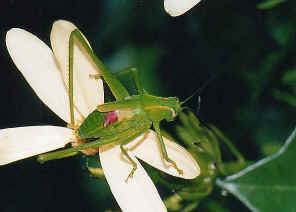
- Caedicia simplex, female length 40mm, nymph length 25mm.
- Common Garden Katydids are also known as Inland Katydid. This katydid look very similar to the Gum Leaf Katydid. The insect, as its common implied, can be easily found in Brisbane gardens. The insects are green in colour resemble leaves. On the top of their abdomen there are the pink and yellow pattern covered by their wings. More information and pictures please click here.
- Katydid
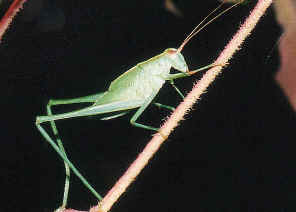
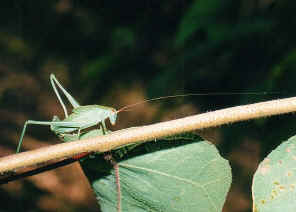
- Caedicia sp., nymph length 20mm.
- We found this green katydid nymph on a small tree top during winter at Toohey Forest. It was moving slowing to escape from our disturb. The nymph was leaf green in colour and did not have any marking or pattern on its body. Its wing buds were well development showing it could be the last instars, but relatively small in side. We will collect and raise one if we can find them again so that we will know how their adult look like.
- Small Grassland Katydid
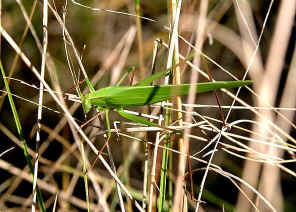
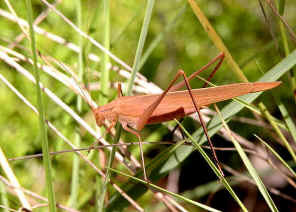
- ? sp., head to wings tip length 30mm
- Pictures taken in Mt Cotton during mid summer. This katydid is relatively small in size. The brown form was found in Alexandra Hill during later summer. More pictures and information please visit this page.
- Mountain Katydid


- Acripeza reticulata, body length 20mm, 25mm
- We found this Mountain Katydid nymph near Yugarapul Park in Sunny Bank, Brisbane. It was September 2002. The nymph was resting on a dry grass. We took it home to see how it grow. It dead two months later, It moulted once within the two months. We can see its wing-buds so it could be its last instars stage when its dead. We do not know why it dead before it matured. More pictures and information please click here.
- Spotted Katydid, Mottled Katydid
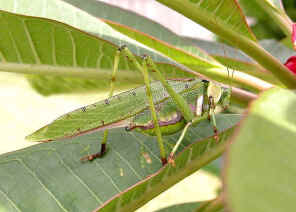
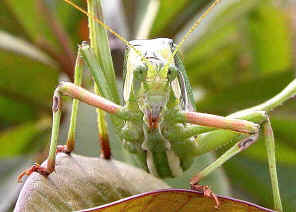
- Ephippitytha trigintiduoguttata, male, body length 65mm
- We sometimes find this katydid in our backyard. The katydid in the above pictures were found on a shop display window during the day in mid summer. We brought it home, put it in our backyard and took those pictures. More information and pictures can be found on this page.
There are some more Katydids yet to be identified in this page.
